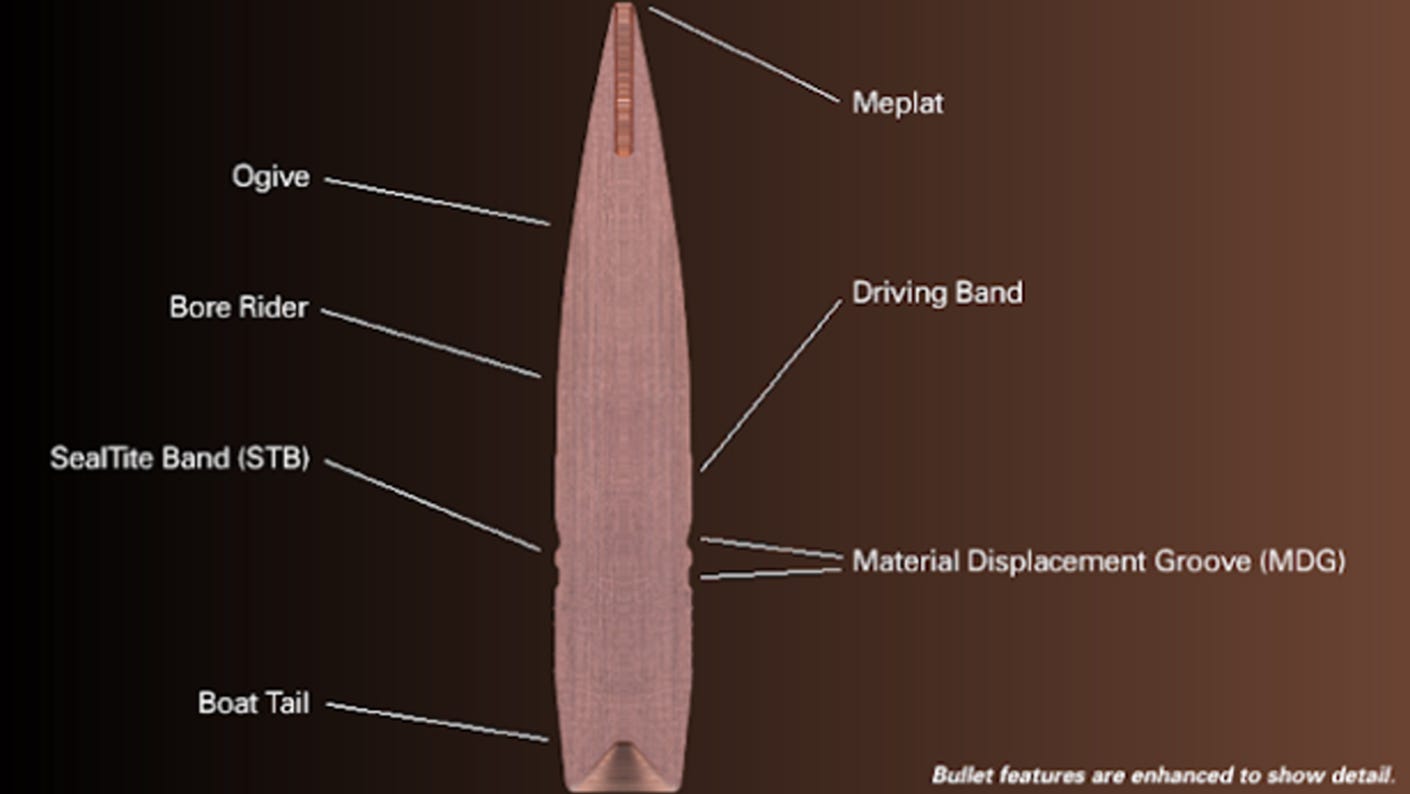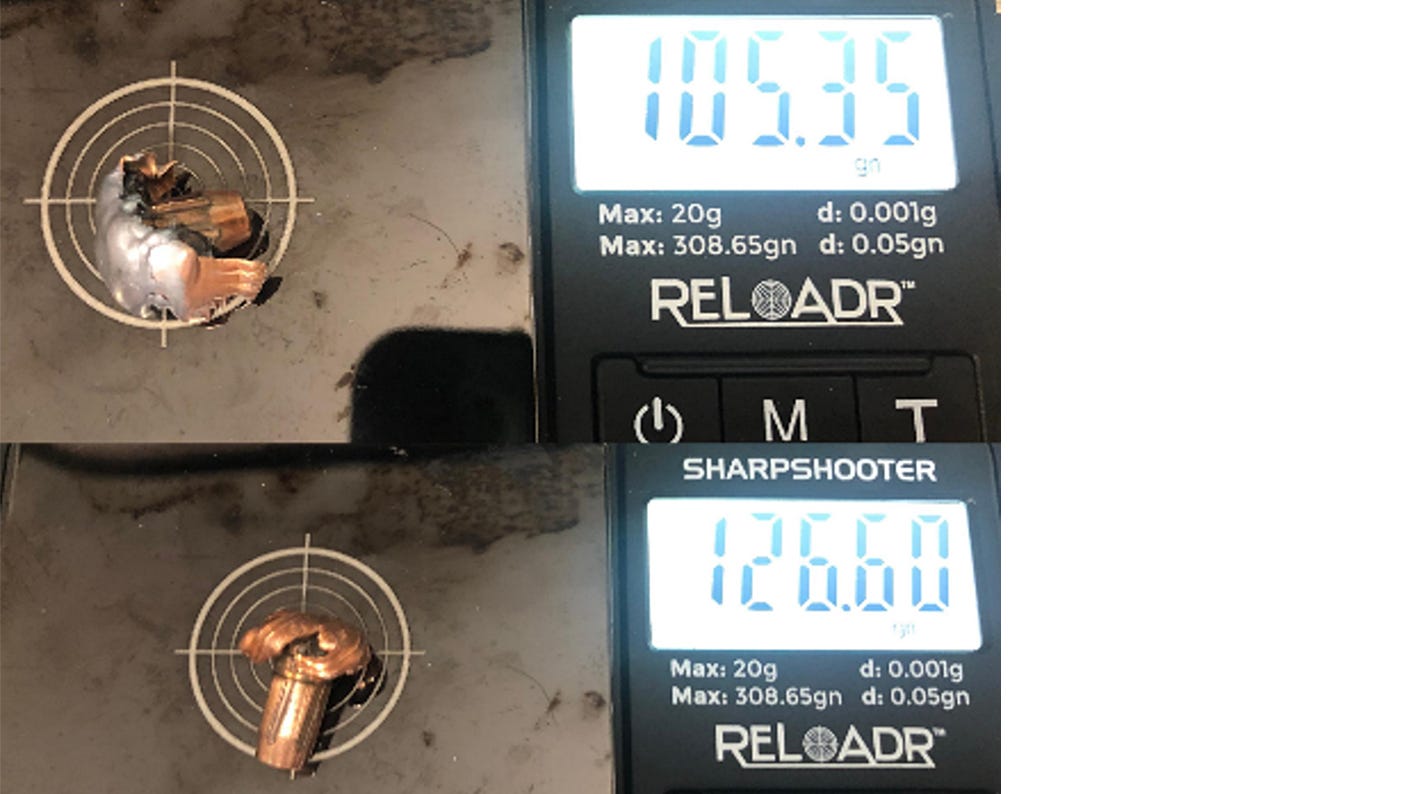Thinking About Going Lead Free this Season?

Which is better for hunting, lead or copper? It might seem like a simple question, but a lot goes in to answering it.
With hunting season right around the corner, one thing a lot of hunters are looking into is monolithic-style bullets. (Bullets that do not include a jacket.) Some states restrict certain types of ammunition because of lead contamination, and there’s some research we’ll get into that shows lead can contaminate your meat.
Monolithic-style bullets are traditionally all copper projectiles, while standard projectiles are traditionally lead encompassed with a jacket. While both of these projectiles are more than suitable for hunting, many wonder what the actual differences are regarding performance. Let’s dive in and look at lead dispersion, accuracy differences, and expansion effects.
Lead Effects
Lead dispersion is the number-one concern for certain states that have demanded hunters only use monolithic-style bullets for hunting because of the history with standard projectiles leaving lead contamination behind. One of the best published studies on the aftereffects of lead dispersion due to fragmentation was written by Clint Wirick and it explains lead bullets can have some negative consequences.
Wirick says, “Bullets made with lead tend to fragment more than other solid monolithic copper bullets … A 2008 study conducted by the Minnesota Department of Natural Resources surveyed the presence of lead fragments in commercially processed venison. In a sample of 1,029 packages of ground venison and 209 packages of whole cut venison, 27% of the ground and 2% of the whole cut venison were found to contain lead fragments.” And, of course, these are not huge pieces of lead obvious to the human eye, meaning they can be easily consumed.
Accuracy
As we talk about lead dispersion and the potential for harmful effects on digestion, we should also mention the differences in accuracy. Given that we fully focus on the projectile itself, and not the other effects like the shooter, temperature variables, component choices, barrel lengths, twists, and more, there is some very surprising results.
Specifically, with monolithics, the idea that they foul your barrel quicker has become a concern for hunters: The more fouling you have in your barrel, the more drastically it will produce bad accuracy and inconsistent velocities. Pair bad accuracy and inconsistent velocities with a hunt where you’ll be shooting a significant distance and it is a recipe for disaster, and a potential for hurting an animal. However, as monolithics have become more popular over the years, the technology has become even better.
For example, let’s address the fouling. Depending on the actual design of the monolithic itself, it can change fouling amounts drastically. Using a bullet like Cutting Edge with their STB design reduces the amount of fouling while also ensuring there will be no pressure escaping around the bullet when fired.
On the other hand, their MDG design allows “for the material to flow into when the STB enters the throat and lands in the rifle barrel. This prevents excess pressure as the soft copper flows freely into them. Keep in mind we are talking about a very minimal amount of material that gets displaced.”

Monolithic technologies have come a long way, reducing the risk of copper fouling while preserving high ballistic performance.
As you can see, this is just a few of the advancements in a bullet technology still changing to this day.
This will also give you an idea of when to clean your rifle. Nothing is worse than going to the range thinking your handloads or ammo are bad, or you are just off that day. If it sounds like a lot of work, next time you clean your barrel, start keeping track of how many rounds you fire each range day.
Expansion Effects
Monolithic bullet expansion is completely different than standard projectiles, one of the biggest differences being fragmentation and penetration. Monolithics, when moving at a slower speed, do not expand much and penetrate very far. When monolithics are traveling fast at their target, there is less penetration and more expansion, unless the monolithic is designed to do otherwise which we will get into shortly.
To put this into perspective, let’s say you are shooting a .264 monolithic at 2750 FPS as it leaves your barrel. If you were to hit your target at 100 yards, you would have extremely good expansion while having perfect amounts of penetration with virtually no fragmentation. Now, let’s say you shoot that bullet at 2750 FPS at a target of 500 yards or more. You will have more penetration and less expansion. Here is a reference for you to see the differences and the article itself.
With a standard hunting projectile, expansion completely depends on the design of the bullet. Most notable, what happens with a standard hunting bullet is a lot of fragmentation at close ranges and a drastic reduction in bullet weight retention.
As an example, here is a photo of a 127-grain monolithic on the bottom of the photo and a 130-grain standard hunting projectile on the top. Both are hitting the gel block with the same foot pounds of energy, with the same components, shot on the same gel block, same rib bone, at the same distance. The standard lost 24.65 grains while the monolithic only lost 0.4 grains.

All other things being equal, a monolithic round retains more of its original mass after impact.
Moreover, with standard hunting projectiles there is a “sweet spot” where fragmentation minimizes due to reliable expansion and velocities of certain distances. That sweet spot is when your standard hunting projectile will retain most of its weight at a certain speed. In other words, it will retain most of its mass at a certain yardage when it hits your target.
Bullet design
The design behind monolithics has drastically changed over the years in a way that suits a specific type of hunting; companies are now designing projectiles based on application.
For example, Hammer Bullets line of monolithics has a design where the bullet itself will retain up to 40-60% of its mass while fragmenting the rest of its integrity. Meanwhile, you have Discreet Ballistics which is at the forefront of making subsonic and super-sonic monolithics that are absolutely devastating even at slow speeds. Their monolithics are designed to expand at super slow speeds while allowing hunters to be discrete and have a hearing safe firearm while using a suppressor. Pair this with feral hogs or other varmints, and you are sure to have a great time.
Conclusion
Winner? Neither. Each bullet gets its job done.
Depending on which caliber and style you go with, they are virtually the same price. There is a time and place for everything. The real difference between a monolithic and a standard hunting projectile completely depends upon the standard projectile it’s being compared to. While there is a plethora of different types of standard hunting projectiles, one style will perform better than another.
However, as we have tested several different projectiles, the biggest advantage monolithics have is weight retention, virtually no fragmentation, reliable expansion, and performing well regardless of distance on game within reasonable and ethical distances.
As far as lead contamination goes, I have used standard projectiles virtually my whole life while most of you have as well, while never getting lead sickness. Now that I have read that study Clint Wirick wrote, I’d rather not take the risk as I get older, and I’ll give monolithics more of a shot on hunting trips. Pun intended.
Want to learn more about lead v. non-lead ammo? Checkout our podcast “Get the Lead Out, Keep it in … or a Little Bit of Both.” Want to take a deep dive into the world of reloading? Head over to reloadingallday.com.
BIO

Blake
Blake has been writing reloading articles for three years and helping out within the community to further enhance reloading education. In his free time, he works within the community to help out new hand-loaders by educating them on the many variables that come with this wonderful hobby. His passion is solely based on educating others so that they may pass on that information to future generations, keeping the art of hand-loading alive.
Disclaimer: The content you are about to read is for demonstration purposes only. This includes videos, blog posts, articles, and all information associated with this website. Do not attempt anything you see on this website. Again, these are for demonstration purposes only. If you see reloading data and or comments, please refer to the manufacturer of your choice and contact a technician. We are not responsible for any false data or comments from individuals. Again, this is a demonstration for reloading. Please contact or take classes from certified reloading instructors or contact the manufacturer of your choice. Please, do not attempt to tamper or modify with ammunition or firearms. Seek out a licensed professional or gunsmith. Any information you watch or read on this website must be assumed to have an error and should not be performed. Reloadingallday will not and cannot be held responsible for harm caused to readers and watchers. The material that is covered is for demonstration purposes only. Please be aware that hand-loading and other topics covered are very dangerous and you are within full responsibility and liability for your own actions. Reloadingallday is also not responsible or liable for any damage that might be caused due to those who enter this website and read any of our material or watch. Again, this is for demonstration purposes only. By reading this article, you are agreeing that you are responsible for yourself, everyone around you, watchers, viewers, commenters, and fans. You are also agreeing that you are responsible for the safety and property as follows: yourself, everyone around you, watchers, viewers, commentators, and fans. Also, you are accepting that you agree with everything this disclaimer has written down.
It’s our hope you can learn and laugh along with the expert voices we feature on this blog. We want to be clear that the opinions you see featured here are just that: opinions. The content belongs to the authors and is not necessarily the opinion of Vortex Optics.
To learn more about what you’ve read, please like, follow, and otherwise support our authors.










